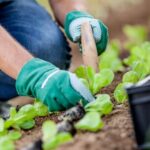Are you considering starting your own vegetable garden? Whether you have a green thumb or are new to gardening, cultivating your own vegetables can be a rewarding and enriching experience.
From choosing the right location to harvesting your homegrown produce, there are many facets to consider when embarking on this journey. In this article, we will explore the world of vegetable gardens, including the benefits of growing your own vegetables, essential tools and supplies, selecting the best vegetables to grow, maintaining your garden, and troubleshooting common issues.
Growing your own vegetables can be an incredibly fulfilling endeavor that not only provides fresh and nutritious produce but also allows you to connect with nature and understand the process of food production. With the rising interest in sustainability and healthy living, more people are turning to vegetable gardens as a way to take control of their food sources while enjoying the pleasures of nurturing plants from seedlings to fully-grown vegetables.
Before diving into the logistics of starting a vegetable garden, it’s important to understand the various advantages that come with growing your own produce. Not only does it provide an opportunity for physical activity and stress relief through gardening, but it also offers access to organic and pesticide-free vegetables that may not be readily available at supermarkets.
Additionally, tending to a vegetable garden can bring a sense of accomplishment as you witness the fruits (or rather, vegetables) of your labor thrive and flourish. So let’s get started on this exciting journey into the world of vegetable gardening.
Benefits of Growing Your Own Vegetables
Growing your own vegetables in a home garden can bring numerous benefits to you and your family. Not only does it provide a fresh and healthy source of produce, but it also offers a sense of fulfillment and satisfaction. Here are some key benefits of growing your own vegetables:
- Nutritional Value: Freshly picked vegetables are at their peak nutritional value, providing you and your family with essential vitamins, minerals, and antioxidants that may be lost during transportation and storage.
- Cost Savings: By growing your own vegetables, you can significantly reduce your grocery bill while also ensuring that you have access to organic produce free from harmful pesticides and chemicals.
- Environmental Impact: Vegetable gardens contribute to the reduction of carbon footprint as they eliminate the need for transportation, excessive packaging, and refrigeration associated with store-bought produce.
In addition to these benefits, vegetable gardens also promote physical activity through gardening tasks such as planting, weeding, watering, and harvesting. This can serve as a form of exercise and stress relief while connecting you with nature. Furthermore, the act of tending to a vegetable garden fosters a deeper appreciation for the environment and encourages sustainable living practices.
Overall, cultivating your own vegetable garden offers fulfillment in knowing that you are taking an active role in providing food for yourself and your loved ones while promoting health, sustainability, and environmental consciousness within your household.
Choosing the Right Location for Your Vegetable Garden
When it comes to choosing the right location for your vegetable garden, there are several factors to consider in order to ensure a successful and bountiful harvest. The first step is to identify a spot in your yard that receives plenty of sunlight, as most vegetables require at least 6-8 hours of direct sunlight each day. It’s also important to choose a location with good soil drainage, as standing water can lead to root rot and other issues.
In addition to sunlight and soil drainage, you’ll also want to consider proximity to water sources. It’s best to place your vegetable garden near a water supply so that you can easily and efficiently water your plants. This will help prevent dehydration and ensure that your vegetables receive the hydration they need to thrive.
Furthermore, when selecting a location for your vegetable garden, it’s important to take into account proximity to other structures or plants. Make sure that nearby trees or large shrubs won’t cast too much shade on your garden, as this can interfere with the amount of sunlight your vegetables receive. Additionally, be mindful of any potential hazards such as overhanging branches or tree roots that could encroach upon your garden space.
By carefully considering these factors and choosing a suitable location for your vegetable garden, you’ll be setting yourself up for success and enjoying the many benefits of homegrown produce. Whether you have limited space or an expansive yard, there are creative ways to maximize the potential for growing an abundant variety of fresh vegetables in your very own backyard. With proper planning and attention to detail, you can create a thriving oasis of homegrown goodness in no time.
Essential Tools and Supplies for Vegetable Gardening
When starting a vegetable garden, it’s essential to have the right tools and supplies to ensure successful growth and maintenance of your plants. Whether you’re a seasoned gardener or a beginner, having the necessary equipment will make the process much smoother and more enjoyable.
Basic Gardening Tools
Some of the basic tools you’ll need for vegetable gardening include a trowel, hand fork, pruning shears, and a hoe. These tools will help with planting, maintaining soil health, pruning, and weeding. Make sure to invest in quality tools that will last for multiple growing seasons.
Soil and Fertilizer
Having good quality soil is crucial for the success of your vegetables gardens. Consider getting a soil test kit to determine the pH levels and nutrient content of your soil. Additionally, invest in organic compost and fertilizer to improve soil fertility and provide essential nutrients for your plants.
Watering Equipment
Proper watering is key to a thriving vegetable garden. Invest in a watering can or hose with an adjustable nozzle for controlled water flow. Consider installing a drip irrigation system if you have a larger garden to ensure consistent moisture levels for your plants.
Protective Gear
Don’t forget about protecting yourself while working in your vegetable garden. Invest in durable gardening gloves, sunscreen, a wide-brimmed hat, and knee pads to keep yourself comfortable and protected from the sun during long hours of tending to your garden.
Ensuring you have the essential tools and supplies will set you up for success when establishing and maintaining your vegetable garden. With the right equipment on hand, you’ll be well-prepared to nurture healthy plants and enjoy an abundant harvest from your homegrown vegetables.
Selecting the Best Vegetables to Grow in Your Garden
When it comes to selecting the best vegetables to grow in your garden, there are several factors to consider. The climate and soil in your area, as well as your personal preferences and cooking habits, will all play a role in determining which vegetables will thrive in your garden. Here are some tips for choosing the right vegetables for your vegetable garden:
- Consider the climate: Different vegetables thrive in different climates. For example, tomatoes and bell peppers do well in warm climates, while kale and carrots can withstand cooler temperatures.
- Assess your soil: Take a look at the soil in your garden and determine its pH level and nutrient content. Some vegetables, such as potatoes and radishes, prefer loamy soil with good drainage, while others like spinach and lettuce thrive in rich, well-draining soil.
- Think about your cooking habits: Consider which vegetables you frequently use in your cooking. If you’re a fan of salads, then lettuce, cucumbers, and cherry tomatoes might be good choices for your garden. If you enjoy stir-frying veggies, then consider growing broccoli, snap peas, and bell peppers.
Once you’ve taken these factors into account, it’s time to start selecting the specific varieties of each vegetable that you want to include in your garden.
- Tomatoes: There are countless varieties of tomatoes to choose from, including beefsteak tomatoes for slicing and eating fresh, cherry tomatoes for snacking on straight from the vine, and paste tomatoes for making sauces and salsas.
- Zucchini: This prolific summer squash is easy to grow and produces an abundance of fruit. Look for compact or bush varieties if you have limited space.
- Bell Peppers: These come in a variety of colors – red, yellow, orange or green – so choose based on your culinary preferences. Bell peppers can be eaten raw or cooked.
By carefully considering these factors and choosing the best vegetable varieties for your garden, you can ensure a bountiful harvest of homegrown produce that suits both your tastes and growing conditions. With careful planning and attention to detail upfront,cyou’ll be rewarded with an abundant supply of fresh vegetables throughout the growing season.
Maintaining Your Vegetable Garden
Once you’ve started your vegetable garden, it’s important to maintain it properly to ensure a successful harvest. One of the most crucial aspects of maintenance is watering. Most vegetables need about 1-1.5 inches of water per week, either from rainfall or irrigation.
It’s important to water deeply and less frequently to encourage deep root growth and drought tolerance. Using a soaker hose or drip irrigation can help ensure that the water reaches the roots where it’s needed most.
In addition to watering, regular weeding is essential in vegetable gardens. Weeds compete with your vegetables for nutrients and water, so it’s important to keep them under control. Consider using mulch to help prevent weeds from sprouting, and regularly pull any weeds that do appear.
Pest control is another important aspect of maintaining a healthy vegetable garden. Keep an eye out for common pests like aphids, caterpillars, and beetles, and remove them by hand when possible. You can also use organic pesticides as a last resort if pest populations become overwhelming.
| Aspect | Recommendation |
|---|---|
| Watering | 1-1.5 inches of water per week; deep and infrequent watering; consider soaker hose or drip irrigation |
| Weeding | Regular weeding; use mulch to prevent weed growth; remove weeds by hand |
| Pest Control | Keep an eye out for common pests; remove pests by hand when possible; use organic pesticides as a last resort |
Harvesting and Storing Your Homegrown Vegetables
When it comes to vegetable gardens, harvesting and storing your homegrown vegetables is one of the most rewarding aspects. Not only do you get to enjoy the fruits of your labor, but you also get to savor the fresh flavors of your own produce. In this section, we will discuss the best practices for harvesting and storing your homegrown vegetables so that you can enjoy them for as long as possible.
Harvesting Your Vegetables
The key to harvesting your homegrown vegetables is picking them at the peak of ripeness. This ensures that they are full of flavor and nutrients. Different vegetables have different signs of ripeness, so it’s important to familiarize yourself with each type of vegetable in your garden. For example, tomatoes should be harvested when they are fully colored and slightly soft to the touch, while carrots should be harvested when they have reached the desired size and color.
Storing Your Homegrown Vegetables
Proper storage is essential for prolonging the shelf life of your homegrown vegetables. Some vegetables, like onions and garlic, can be stored in a cool, dry place for several months. Others, such as leafy greens and herbs, are best stored in the refrigerator to maintain their freshness. It’s also important to handle your vegetables carefully during storage to prevent bruising or damage that can lead to spoilage.
Prolonging Freshness
If you have an abundance of produce from your vegetable garden, consider preserving some for later use. You can freeze, can, or pickle certain vegetables to extend their shelf life. This allows you to enjoy the taste of your homegrown vegetables throughout the year. Additionally, sharing your excess harvest with friends and family is a great way to spread the joy of growing your own vegetables while preventing waste.
By following proper harvesting and storage techniques, you can maximize the enjoyment of your homegrown vegetables from your vegetable garden throughout the growing season and beyond.
Troubleshooting Common Issues in Vegetable Gardens
When it comes to maintaining a vegetable garden, there are several common issues that gardeners may encounter. One of the most common problems is pests and diseases. Some common garden pests include aphids, snails, and caterpillars, while diseases like powdery mildew and blight can also affect vegetable plants. It’s important to regularly inspect your plants for any signs of these issues and take appropriate measures to control them.
Another common issue in vegetable gardens is nutrient deficiency. Soil that lacks essential nutrients can result in stunted growth and poor fruit production. Conducting a soil test can help you identify any deficiencies and allow you to amend the soil accordingly. Adding organic matter or fertilizer can help ensure that your plants have access to the nutrients they need for healthy growth.
Lastly, inconsistent watering can also be a common issue in vegetable gardens. Overwatering or underwatering can both have detrimental effects on the health of your plants. It’s important to establish a regular watering schedule and adjust it as needed based on weather conditions. Using mulch around your plants can also help retain moisture in the soil and reduce water evaporation.
It’s crucial for vegetable gardeners to be proactive in identifying and addressing these common issues in order to maintain a healthy and productive garden.
| Common Issues | Solutions |
|---|---|
| Pests and Diseases | Regular inspection & appropriate measures for control |
| Nutrient Deficiency | Conducting soil test & amending the soil with organic matter or fertilizer |
| Inconsistent Watering | Establishing a regular watering schedule & using mulch |
Conclusion
In conclusion, cultivating your own vegetable garden can be a deeply rewarding experience. Not only does it provide you with a constant supply of fresh and nutritious produce, but it also offers numerous other benefits.
Through the process of nurturing and tending to your plants, you can connect with the earth and gain a greater appreciation for the natural world. The act of growing your own vegetables is not only good for your physical health, but it also promotes mental well-being and a sense of fulfillment.
Furthermore, maintaining a vegetable garden allows you to have full control over what goes into the food that you eat. You can rest assured that there are no harmful chemicals or pesticides in your homegrown produce, promoting a healthier lifestyle for you and your family. Additionally, growing your own vegetables is also an eco-friendly practice as it reduces reliance on commercially-grown crops that often require extensive transportation and packaging.
Overall, embarking on the journey of planting and nurturing a vegetable garden is a worthwhile endeavor that offers countless rewards. Whether you are looking to improve your diet with fresh and organic produce or simply enjoy spending time outdoors in nature, establishing a vegetable garden can bring joy, satisfaction, and numerous benefits to your life. So roll up your sleeves, grab some seeds and soil, and start reaping the many rewards of growing your own vegetables.
Frequently Asked Questions
What Is a Good Layout for a Vegetable Garden?
A good layout for a vegetable garden typically includes raised beds or rows with adequate spacing between plants to allow for growth and easy access for maintenance. It’s important to consider sunlight, water accessibility, and proper drainage when planning the layout.
What Are Good Vegetables to Grow in a Garden?
Good vegetables to grow in a garden depend on the climate and soil conditions, but some popular options include tomatoes, peppers, zucchini, lettuce, carrots, cucumbers, and green beans. It’s also essential to consider which vegetables your household enjoys eating.
What Grows Well Together in a Vegetable Garden?
Some vegetables that grow well together in a vegetable garden include tomatoes with basil and onions, carrots with lettuce and radishes, and corn with beans and squash. This planting method is known as companion planting and can help deter pests and maximize space effectively.

If you’re looking to get into vegetable gardening, or are just looking for some tips on how to make your current garden better, then you’ve come to the right place! My name is Ethel and I have been gardening for years. In this blog, I’m going to share with you some of my best tips on how to create a successful vegetable garden.





